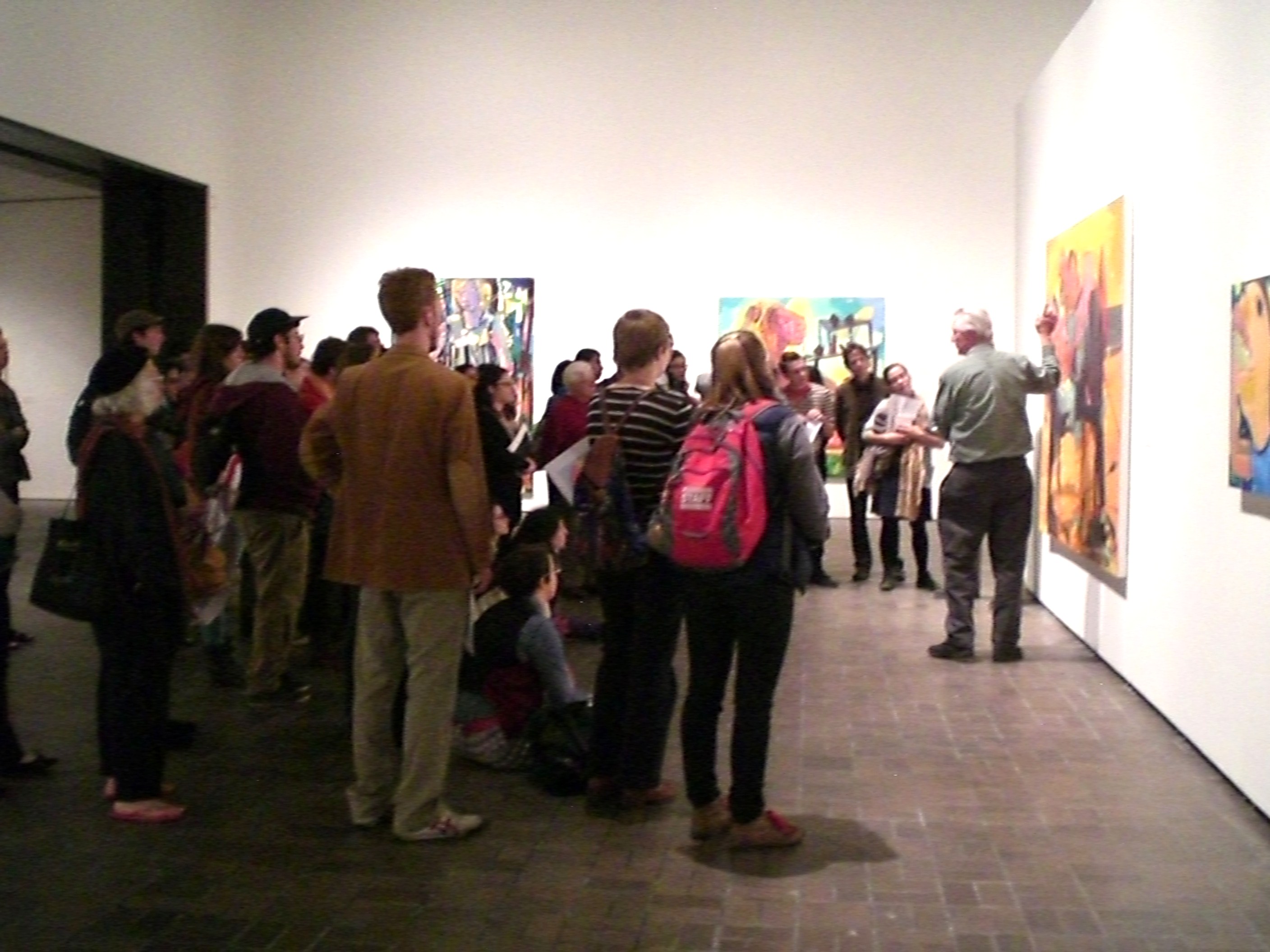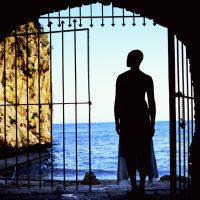Isaac Julien: Western Union: Small Boats
Western Union: Small Boats, one of the most important video installations by acclaimed artist Isaac Julien, will be on view at the Neuberger Museum of Art, Purchase College, SUNY, February 12–May 31, 2020. Western Union, made in 2007, addresses migration across the Mediterranean from Africa to Europe in the early years of the twenty-first century. The work, which has received dozens of accolades and awards, powerfully evokes the trauma of clandestine passage – what it means to journey illegally from one place to another, from one culture to another.
Western Union presents the story of men, women, and children who crossed the ocean in small overcrowded boats that promised escape from Africa to Europe. While the installation explicitly focuses the experience of migrants who attempted to cross the Mediterranean in and before 2007, it resonates in today’s world as nations attempt to enforce their borders against refugees escaping the ravages of war, violence, instability, terrorism, and famine.
The story unfolds on three screens in a visually arresting format. “At a time when US immigration policies are generating controversy on a daily basis, the questions posed by Julien about the movement of bodies and the experience of migration make the subject matter especially compelling,” says Louise Yelin, Professor Emerita, Literature, Purchase College, SUNY, who co-curated the exhibition with Helaine Posner, Chief Curator, Neuberger Museum of Art.
According to Dr. Yelin, Western Union, like all of Julien’s work, uses brilliant images to tell an often-chilling tale. “Employing visual techniques that provide stunning images, Julien presents multiple points of view on migration, juxtaposing the perspectives of the migrants themselves and those of the people who await their arrival on shore.”
As Dr. Yelin points out, Western Union is an act of memory: “It is, among other things, a memorial to those who perished on the journey, but it also follows the survivors to their destination, [in this case] the island of Lampedusa. Presenting the lives of those who do not or cannot tell their own stories, Julien preserves that memory in what he calls a ‘visual archaeological expedition,’ which is intended to ‘outlast the sensationalist treatment of migrants.’”
Western Union: Small Boats is projected onto three large screens that together occupy a large gallery space. As viewers move around in the gallery, they become immersed in the work., Julien collages together scenes of diverse times and places. The work is neither a documentary nor a fixed narrative. Rather, it is compilation of moments – a graveyard for wrecked boats, weary black men sitting in a boat, a woman gazing at the ocean through a doorway, rescuers carrying drowned migrants ashore on their shoulders, a woman in a red dress walking through a sumptuous palace. The soundtrack includes muffled speech, music, and the sound of roiling water that accompanies images of bodies writhing as if fighting not to drown, portraying “the bodily sensation of immersion in a noisy, bubbling, violent sea,” as Julien describes it.
In explaining his use of actors and the brilliant images in the film, Julian said that unlike a traditional documentary which provides a “separation from life,” he wanted the images to render an experience. “[The question was] how to visualize elements of this migratory disaster that became a European political crisis, but without resorting to the dominant mode of news reporting such events…I was trying to counteract the ways that governments and media record events. I wanted to make a work that would outlast the sensationalist treatment of migrants.”
Powerful imagery; difficult subject
Julien trains the camera lens on small details: Arabic names painted in black and yellow on the boat sides; splintered wooden boards; small piles of clothes; an unbuckled life jacket. Yet, he refrains from employing standard documentary narrative or chronology. “You’re not given any points of orientation,” Dr. Yelin explains. “But because the images are so powerful, Julien makes you notice what’s happening. You experience the work which leads you to think hard about what you just saw.”
In his interview with Dr.Yelin, which is included in the catalogue that accompanies the exhibition, Julien sums up the way that Western Union reaches out from its own moment to ours: “Look at Brexit; look at Trump; look at the ways that borders are treated and at how some people want to control the movement of others. The anxiety around borders is a kind of moral panic, and it doesn’t need to be…Obviously, nations will always have rules, but surely there can be smarter ways of…figuring out how to accommodate people seeking economic betterment or escaping wars, famines, discrimination, violence – migrating because they have to…. The question of migration, of who belongs and who does not, who lives and who dies, has only just begun in the name of securing democracy in Europe and beyond. I can’t help but think of the tragedies that lie ahead.”
Isaac Julien: Western Union: Small Boats is organized by the Neuberger Museum of Art and co-curated by Helaine Posner, Chief Curator, and Louise Yelin, Purchase College, SUNY, Professor Emerita, Literature. Generous support for this exhibition is provided by the Roy R. Neuberger Legacy Program Endowment.
About the artist
Isaac Julien’s work is global in scope and multidisciplinary, crossing both geographical and artistic boundaries. His early work, mostly in film and video, focuses on the London scene in which he emerged and foregrounds the expression of diverse—queer, feminist, diasporic—black subjectivities. Subsequently, he branched out: Looking for Langston: A Meditation on Langston Hughes and the Harlem Renaissance (1989), perhaps his best-known film, pays homage to the poet Langston Hughes, among others, and excavates the queer history of the Harlem Renaissance. In recent years, Julien has been making large-scale, immersive, multiscreen gallery and museum-ready installations, among them Western Union: Small Boats (2007), Ten Thousand Waves (2010), and Playtime (2014), all of which trace networks of migration around and across the world, and A Marvelous Entanglement (2019) and Lessons of the Hour (2019), which explore the transnational reach of the abolitionist Frederick Douglass and Lina Bo Bardi, a modernist architect who was born in Italy and lived and worked in Brazil.
He is the recipient of numerous prizes and awards, including the Semaine de la Critique Prize at the 1992 Cannes Film Festival for his 1991 feature Young Soul Rebels and the James Robert Brudner ’83 Memorial Prize for LBGT studies at Yale University in 2016. In 2017, he was made a Commander of the British Empire. Western Union: Small Boats was awarded the Charles Wollaston Award for the most distinguished work in the 2017 Royal Academy Summer Exhibition, and in 2018, Julien was named a Royal Academician.
His work has been exhibited at museums including Zeitz Museum of Contemporary Art Africa, Cape Town (2017), Fondation Louis Vuitton, Paris (2016), MAC Niterói, Rio de Janeiro (2016), Museo Universitario Arte Contemporáneo (MUAC), Mexico City (2016), De Pont Museum, Netherlands (2015), Museum of Modern Art, New York (2013), Art Institute of Chicago (2013), Bass Museum of Art, Miami (2010), Museum Brandhorst, Munich (2009), Irish Museum of Modern Art, Dublin (2005), Centre Pompidou, Paris (2005), and Moderna Museet, Stockholm (2005). He has also presented his work at the Venice Biennale (2015) and Documenta 11 (2002), among other venues.
Programs Planned in Conjunction with the Exhibition:
Wednesday, February 12, 4:30-7 pm (snow date: February 19)
Spring Exhibition Opening Reception
Free with Museum admission. No registration required.
Enjoy an evening with friends from campus and the surrounding community while browsing the galleries filled with incredible works from each of the Spring 2020 exhibitions. Listen to live music; nibble on light refreshments; engage in conversation with artists, curators, and follow art lovers.
Friday, April 3 | 12:00-2:00 pm
Art Sandwiched-In: Isaac Julien: Western Union: Small Boats
Free with Museum Admission; Members at all levels Free
Join us for a guided tour of Isaac Julien: Western Union: Small Boats with Louise Yelin, guest curator.
Art Sandwiched-In is a brown bag lunch-and-learn session that happens the first Friday of every month. Bring your own lunch and socialize with other art lovers from 12:30-1:00 pm in the Museum Snack Bar. The, join a curator for a tour of a current exhibition from 1:00–2:00 pm.
Isaac Julien, Western Union Series No. 1 (Cast No Shadow), 2007 Duratrans image in lightbox
471⁄4 x 471⁄4 in (120 x 120 cm)
Courtesy of the artist and Metro Pictures, New York Photograph by Isaac Julien

About Neuberger Museum of Art
Art at the Heart of Purchase College The Neuberger Museum of Art is Westchester County’s premier museum of modern, contemporary, and African art and an integral part of Purchase College, SUNY. From the mid-century American art and African art that form the core of the collection to the presentation of about ten changing exhibitions each year that range from retrospectives of the work of one artist to thematic surveys of contemporary art to newly-commissioned artist projects, we continue the commitment of founding patron Roy R. Neuberger (1903-2010) by championing the art of our time. A teaching museum, the Neuberger actively promotes cultural and educational opportunities for the community with special attention to reaching out to the culturally and ethnically diverse population of Westchester County and to targeting new audiences. OPEN: Wed-Sun, 12-5 pm Closed Mondays and major holidays
Initiated in 1974 with Roy R. Neuberger’s donation of 108 works of art, the permanent collection of the Neuberger Museum of Art has grown to over 6000 works of uncompromised quality and variety. Featuring prestigious examples of modern, contemporary and African art, holdings include the Roy R. Neuberger Collection of American Art, the Aimee W. Hirshberg and Lawrence Gussman Collections of African Art, the Hans Richter bequest of Dada and Surrealist objects, the George and Edith Rickey Collection of Constructivist art, and American, Mexican and European master works from the collection of the late Dina and Alexander Racolin. The Neuberger Museum of Art continues to collect and exhibit its permanent collection, enacting Mr. Neuberger’s commitment to supporting the work of contemporary artists who examine and expand the ideas of our day.


